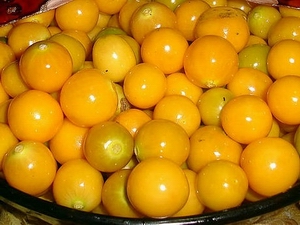A study by the N ational University in Palmira allowed determining this fruit's genetic variability. Its genotype will be useful for future breeding programs.
ational University in Palmira allowed determining this fruit's genetic variability. Its genotype will be useful for future breeding programs.
The cape gooseberry (Peruvian Physalis L.) was considered a wild plant to be used in small crops and, in some cases, as a weed for many years.
Currently it is widely cultivated and is one of Colombia's most important fruits in terms of exports, approximately 6,305 tons annually. This makes it the largest producer of cape gooseberries in the world, followed by South Africa.
The Physalis Peruvian species is native to the South American Andes, mainly in Peru, Colombia and Ecuador, and is the best known of its kind. It is an orange fruit (fleshy berry), covered by a calyx that protects it from pathogens, insects and adverse environmental conditions. Its taste is bittersweet and it has high levels of vitamins A and C, iron and phosphorus, which is why many people attribute its nutritional and medicinal properties.
Colombia's National University in Palmira preserves 222 entries of Peruvian Physalis since 2003, in its cape gooseberry work collection (CTU) as part of the research program on Biological Diversity.
Carlos Eduardo Madriñán, doctoral candidate in Agroecology, said: "In our country, the characterization and evaluation of these work collections has begun to be implemented as an assessment, use, development and conservation of plant genetic resources strategy."
So began a project with the support of teachers Jaime Eduardo Muñoz and Dario Vasquez Herney to learn about the cape gooseberry's plant genetic resources in order to determine their genetic variability, structure and genotype.
"The trial was conducted in three phases. In the first phase we chose 29 representative introductions from the CTU, the second trial was carried out under an experimental design of randomized complete blocks, and in the last phase the information was collected using quantitative and qualitative descriptors previously selected, "said Madriñán.
The study was conducted in the Natural Reserve "La Albecia", in Regaderos, part of the Municipality of El Cerrito (Valle del Cauca).
After the trials, by means of an dendrogram, the researchers observed two groupings within the 29 introductions that were related with the similarities and differences of the qualitative characteristics were evaluated.
"We observed that the Department of Nariño had a high percentage of participation in all of the groups, which explains why the qualitative differences were not highly significant," said Madriñán.
"The potentially important materials to be planted in the evaluated area were the UNPU138, UNPU176, UNPU157, UNPU218, UNPU194 and UNPU211 entries in which the fruits had the largest amounts of soluble solids and were heavier," said the agro-ecologist.
This study, which can be used to identify a favourable genotype for breeding programs of the fruit, has great potential.
 ational University in Palmira allowed determining this fruit's genetic variability. Its genotype will be useful for future breeding programs.
ational University in Palmira allowed determining this fruit's genetic variability. Its genotype will be useful for future breeding programs.The cape gooseberry (Peruvian Physalis L.) was considered a wild plant to be used in small crops and, in some cases, as a weed for many years.
Currently it is widely cultivated and is one of Colombia's most important fruits in terms of exports, approximately 6,305 tons annually. This makes it the largest producer of cape gooseberries in the world, followed by South Africa.
The Physalis Peruvian species is native to the South American Andes, mainly in Peru, Colombia and Ecuador, and is the best known of its kind. It is an orange fruit (fleshy berry), covered by a calyx that protects it from pathogens, insects and adverse environmental conditions. Its taste is bittersweet and it has high levels of vitamins A and C, iron and phosphorus, which is why many people attribute its nutritional and medicinal properties.
Colombia's National University in Palmira preserves 222 entries of Peruvian Physalis since 2003, in its cape gooseberry work collection (CTU) as part of the research program on Biological Diversity.
Carlos Eduardo Madriñán, doctoral candidate in Agroecology, said: "In our country, the characterization and evaluation of these work collections has begun to be implemented as an assessment, use, development and conservation of plant genetic resources strategy."
So began a project with the support of teachers Jaime Eduardo Muñoz and Dario Vasquez Herney to learn about the cape gooseberry's plant genetic resources in order to determine their genetic variability, structure and genotype.
"The trial was conducted in three phases. In the first phase we chose 29 representative introductions from the CTU, the second trial was carried out under an experimental design of randomized complete blocks, and in the last phase the information was collected using quantitative and qualitative descriptors previously selected, "said Madriñán.
The study was conducted in the Natural Reserve "La Albecia", in Regaderos, part of the Municipality of El Cerrito (Valle del Cauca).
After the trials, by means of an dendrogram, the researchers observed two groupings within the 29 introductions that were related with the similarities and differences of the qualitative characteristics were evaluated.
"We observed that the Department of Nariño had a high percentage of participation in all of the groups, which explains why the qualitative differences were not highly significant," said Madriñán.
"The potentially important materials to be planted in the evaluated area were the UNPU138, UNPU176, UNPU157, UNPU218, UNPU194 and UNPU211 entries in which the fruits had the largest amounts of soluble solids and were heavier," said the agro-ecologist.
This study, which can be used to identify a favourable genotype for breeding programs of the fruit, has great potential.





